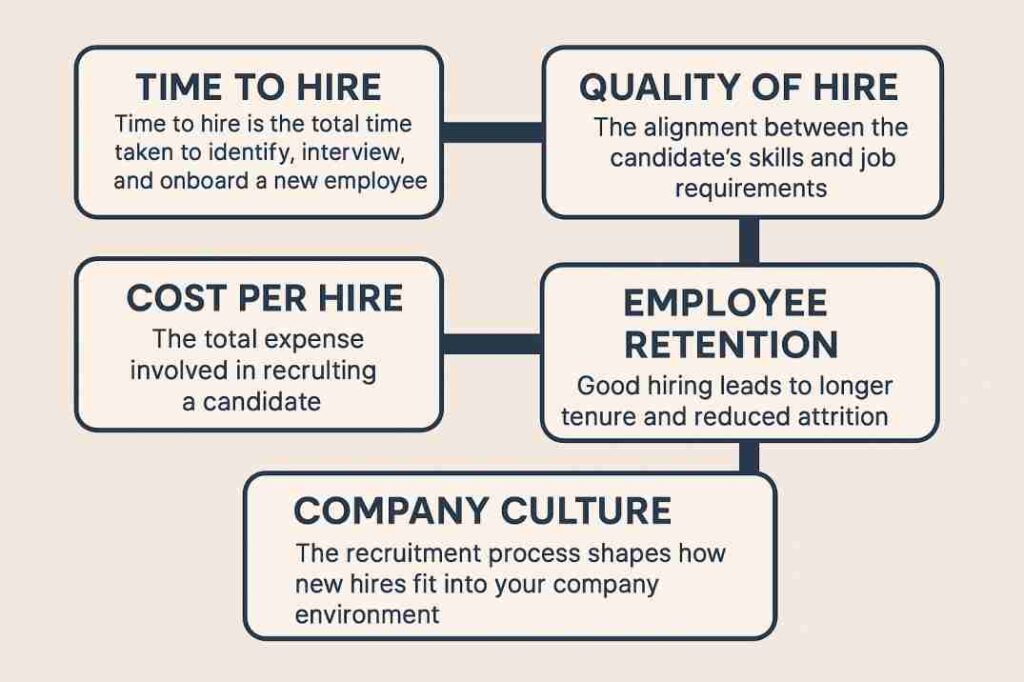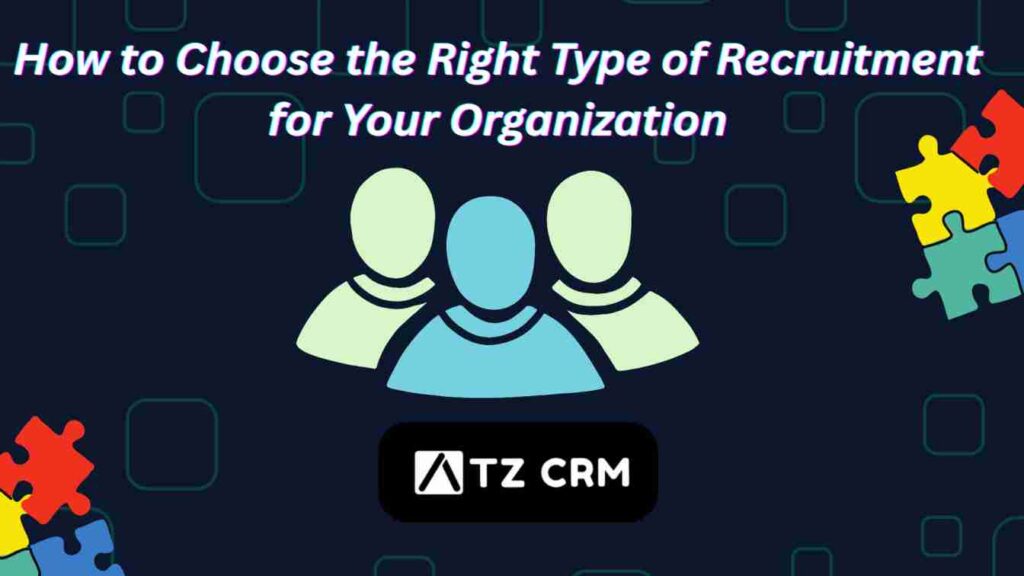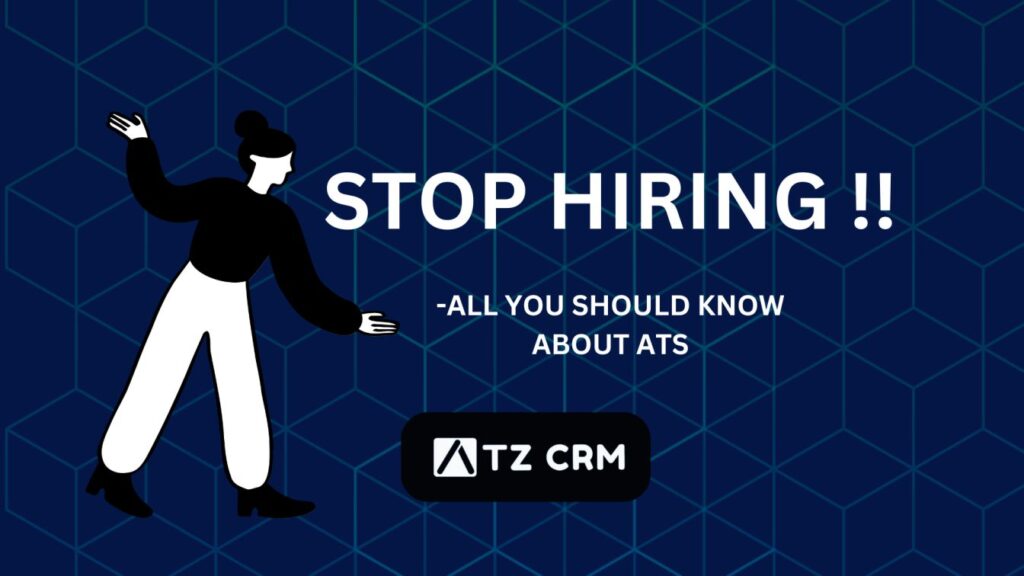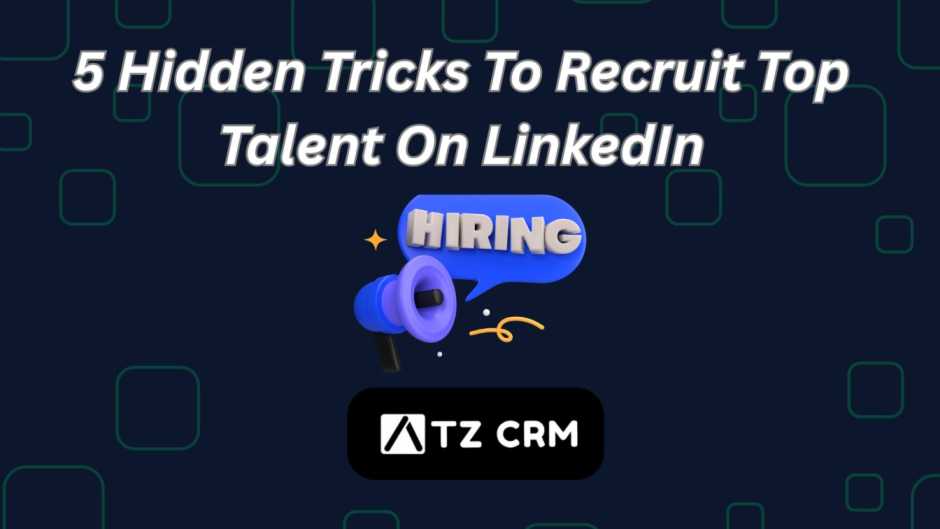Introduction
One of the most important aspects of an organization’s success is hiring the proper people.Whether you’re building a startup, scaling a small business, or expanding a large enterprise, hiring the right people is more than just filling vacancies—it’s about aligning your workforce with your company’s long-term goals and culture.
Choosing the right recruitment type can significantly impact your productivity, budget, and employee retention rates. With numerous hiring strategies available today—ranging from internal recruitment to freelance hiring—knowing which one to use and when is crucial. In this blog, we’ll explore each type of recruitment, guide you on how to choose the most suitable one for your organization, and show you how tools like ATZ CRM can simplify and optimize your recruitment process.
Why the Right Recruitment Strategy Matters
A company’s recruitment strategy influences more than just who joins the team. It also affects:
- Time to hire: Time to hire is the total time taken to identify, interview, and onboard a new employee.
- Cost per hire: The total expense involved in recruiting a candidate.
- Quality of hire: The alignment between the candidate’s skills and job requirements.
- Employee retention: Good hiring leads to longer tenure and reduced attrition.
- Company culture: The recruitment process shapes how new hires fit into your company environment.
Making a poor hiring decision can be costly and cause significant disruptions. Industry studies indicate that an unsuitable hire can result in expenses totaling as much as 30% of the employee’s yearly salary. Therefore, choosing the appropriate recruitment strategy is a necessity, not just a choice.
Related Blog: 5 Hidden Tricks To Recruit Top Talent On LinkedIn

Types of Recruitment and When to Use Them
Here’s an in-depth look at the various recruitment methods and how each can be strategically applied.
1. Internal Recruitment
Using current employees to fill job openings is known as internal recruitment.. It could be through promotions, transfers, or departmental shifts.
Pros:
- Cost-efficient and quick
- Increases employee motivation
- Reduces onboarding and training time
Cons:
- May cause internal competition
- Limits fresh perspectives
- Could create role gaps in other departments
Ideal for: Organizations looking to promote loyalty and career development
2. External Recruitment
This approach involves candidates from outside the organization. It’s commonly done through job portals, advertisements, or social platforms.
Pros:
- Access to a broader talent pool
- Brings in new ideas and skills
- Ideal for roles requiring innovation or change
Cons:
- Higher cost and time investment
- Longer onboarding process
Ideal for: Roles needing specific skills not found internally.
Related blog: How Free CRM Can Grow Your Business Without Extra Cost
3. Campus Recruitment
Engaging with colleges and universities to hire fresh graduates is a great way to build a future workforce.
Pros:
- Cost-effective
- Easier to mold fresh talent
- Boosts brand visibility among young talent
Cons:
- Lack of experience
- Higher training requirements
Ideal for: Entry-level positions, internships, and long-term workforce planning.
Related blog: Discover 10 Free Most Powerful ATS for Small Businesses
4. Recruitment Agencies
Agencies specialize in sourcing and screening candidates, especially for niche roles.
Pros:
- Saves time and effort
- Industry expertise and wider network
- Great for confidential roles
Cons:
- Expensive service fees
- Less control over candidate vetting
Ideal for: Executive-level roles, urgent hires, or when in-house HR lacks bandwidth.
5. Freelance or Contractual Hiring
Hiring based on projects offers adaptability and access to global expertise.
Pros:
- Cost-effective for short-term needs
- Offers flexibility in scaling teams
- Faster hiring cycles
Cons:
- Less integration with company culture
- Risk of inconsistency in performance
Ideal for: Startups, marketing agencies, creative roles, or tech development projects.
Related blog: ATS vs. CRM: What’s the Better Choice?
6. Employee Referrals
Referrals involve current employees recommending candidates for open roles.
Pros:
- Pre-vetted talent
- Faster hiring process
- High cultural alignment
Cons:
- Could limit diversity
- Risk of favoritism
Ideal for: Companies with a good team culture and trust in internal networks.
7. Online Job Portals and Social Media
Using platforms like LinkedIn, Naukri, and Indeed to post job ads is standard for most companies.
Pros:
- Wide reach and visibility
- Economical options available
- Real-time application tracking
Cons:
- High volume of irrelevant applicants
- Time-consuming filtering
Ideal for: Mass hiring or mid-level roles.
How to Choose the Right Recruitment Method
Now that we’ve explored the options, how do you choose what works for your business?
1. Assess the Nature of the Role
- Is it strategic, technical, or creative?
- Does it require leadership or hands-on execution?
- Is it temporary, permanent, or project-based?
Your answers will guide whether you need internal promotions, fresh talent, or freelancers
2. Establish Your Recruitment Budget
Certain positions warrant higher recruitment expenses (like a CTO), whereas others do not. Align your approach with your financial plan. Utilizing freelancers and referrals can be more budget-friendly, while hiring agencies and executive search firms tends to be pricier.
3. Urgency of Hiring
Is there an immediate need for someone? Referrals, job boards, or freelancers can provide swift solutions. Campus recruitment or headhunting generally require a longer timeframe.
4. Cultural Fit
If you prioritize attitude and values over technical skill, employee referrals or internal hiring may yield better long-term hires.
5. Future Growth Potential
Hiring new graduates and promoting from within aid in planning for long-term succession, whereas freelancers serve as temporary resources.
Creating a Recruitment Strategy: Step-by-Step
To implement the right type of recruitment, follow this blueprint:
- Define the role and its objectives
- Choose 1-2 recruitment types based on role nature
- Set clear hiring timelines and budgets
- Use a recruitment CRM like ATZ CRM
- Create standardized evaluation metrics
- Track outcomes and optimize the process
Why Technology is Essential in Recruitment
The best strategy still fails if execution is poor. That’s where recruitment tools like ATZ CRM come in. Whether you use internal hiring or external agencies, ATZ CRM can handle the workflow seamlessly.
ATZ CRM: Your All-in-One Recruitment Partner
What is ATZ CRM?
ATZ CRM is a cloud-based platform designed to streamline and automate the recruitment process for businesses of all sizes. It helps you manage candidate data, communicate efficiently, and track hiring progress with precision.
Key Benefits of Using ATZ CRM
1. All Candidate Data in One Place
Track resumes, interview notes, and emails—all centralized.
2. Recruitment Automation
From scheduling interviews to sending updates, save time with automation.
3. Custom Workflows
Set different workflows for interns, full-time employees, freelancers, or senior hires.
4. Performance Analytics
Get insights on time-to-hire, top-performing recruitment channels, and conversion rates.
5. Collaboration Tools
HR teams, hiring managers, and decision-makers can provide input on candidates in real-time.
6. Enhanced Candidate Experience
Automated, yet personalized communication helps candidates feel valued throughout the process.
Example Use Case
Imagine your company is hiring:
- A marketing intern
- A product manager
- A part-time UI/UX designer
Using ATZ CRM, you can:
- Create custom workflows for each role
- Track each applicant’s status
- Send follow-up emails and reminders
- Share evaluation scores with your team
- Generate reports on where you found the best candidates
This means less time spent on admin work—and more time focusing on hiring the right talent.
Mistakes to Avoid When Choosing a Recruitment Type
- Assuming one size fits all: Different roles need different approaches.
- Ignoring technology: Manual processes waste time and lead to errors.
- Concentrating solely on technical abilities: Cultural alignment and interpersonal skills hold equal significance.
- Over-relying on external sources: You may overlook great internal candidates.
Related blog: The Ultimate Recruit CRM Showdown: Best ATS Ranked
Conclusion
Choosing the right type of recruitment is not a one-time decision—it’s a strategic process that evolves with your organization’s goals, workforce structure, and market conditions. Each hiring method has its place, but the magic lies in choosing the right one at the right time.
By understanding each recruitment type’s pros and cons and implementing tools like ATZ CRM, you can build an efficient, data-driven, and scalable recruitment system.
If you’re ready to take your hiring process to the next level, it’s time to move beyond spreadsheets and outdated methods. Let your recruitment strategy reflect your ambition—and let ATZ CRM be the engine behind it.
FAQs
- What is the most cost-effective recruitment method for small businesses?
Internal recruitment and employee referrals are usually the most cost-effective methods. They save time, reduce hiring costs, and often result in better cultural fit. - How does ATZ CRM help in recruitment?
ATZ CRM streamlines the hiring process by organizing candidate data, automating follow-ups, and providing performance analytics to improve hiring decisions. - Can I use multiple recruitment types at once?
Yes! Many organizations combine methods like job portals, internal promotions, and referrals to cast a wider net and hire the best talent.
Experience the full power of ATZ CRM with a free trial – no credit card needed!
Test all our features before making a commitment. Ready to see our ATS + CRM in action?


